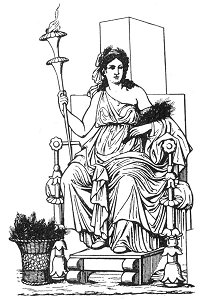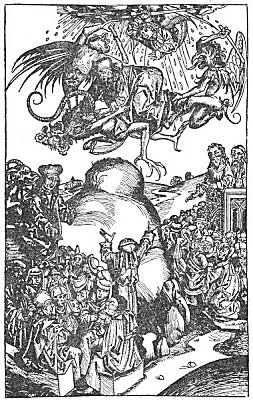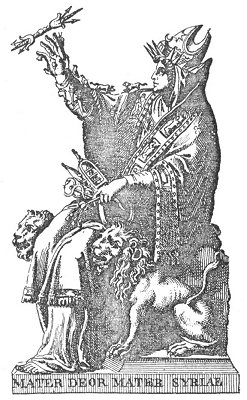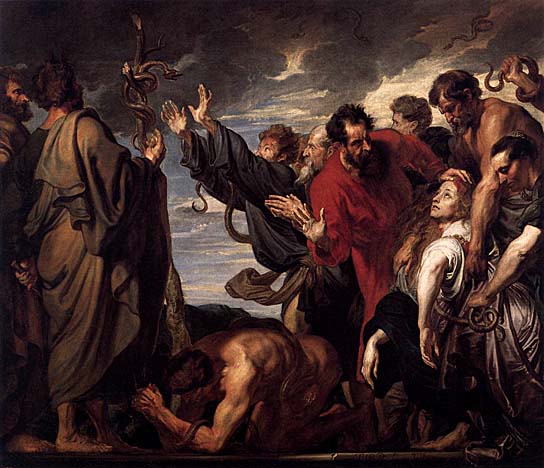In contrast to the idea of Hades as a state of darkness below, the gods were said to inhabit the tops of mountains, a well-known example being Mount Olympus, where the twelve deities of the Greek pantheon were said to dwell together. In his initiatory wanderings the neophyte therefore entered chambers of ever-increasing brilliancy to portray the ascent of the spirit from the lower worlds into the realms of bliss. As the climax to such wanderings he entered a great vaulted room, in the center of which stood a brilliantly illumined statue of the goddess Ceres. Here, in the presence of the hierophant and surrounded by priests in magnificent robes, he was instructed in the highest of the secret mysteries of the Eleusis. At the conclusion of this ceremony he was hailed as an Epoptes, which means one who has beheld or seen directly. For this reason also initiation was termed autopsy. The Epoptes was then given certain sacred books, probably written in cipher, together with tablets of stone on which secret instructions were engraved.
In The Obelisk in Freemasonry, John A. Weisse describes the officiating personages of the Eleusinian Mysteries as consisting of a male and a female hierophant who directed the initiations; a male and a female torchbearer; a male herald; and a male and a female altar attendant. There were also numerous minor officials. He states that, according to Porphyry, the hierophant represents Plato’s Demiurgus, or Creator of the world; the torch bearer, the Sun; the altar man, the Moon; the herald, Hermes, or Mercury; and the other officials, minor stars.
From the records available, a number of strange and apparently supernatural phenomena accompanied the rituals. Many initiates claim to have actually seen the living gods themselves. Whether this was the result of religious ecstasy or the actual cooperation of invisible powers with the visible priests must remain a mystery. In The Metamorphosis, or Golden Ass, Apuleius thus describes what in all probability is his initiation into the Eleusinian Mysteries:
“I approached to the confines of death, and having trod on the threshold of Proserpine I, returned from it, being carried through all the elements. At midnight I saw the sun shining with a splendid light; and I manifestly drew near to, the gods beneath, and the gods above, and proximately adored them.”
Women and children were admitted to the Eleusinian Mysteries, and at one time there were literally thousands of initiates. Because this vast host was not prepared for the highest spiritual and mystical doctrines, a division necessarily took place within the society itself. The higher teachings were given to only a limited number of initiates who, because of superior mentality, showed a comprehensive grasp of their underlying philosophical concepts. Socrates refused to be initiated into the Eleusinian Mysteries, for knowing its principles without being a member of the order he realized that membership would seal his tongue. That the Mysteries of Eleusis were based upon great and eternal truths is attested by the veneration in which they were held by the great minds of the ancient world. M. Ouvaroff asks, “Would Pindar, Plato, Cicero, Epictetus, have spoken of them with such admiration, if the hierophant had satisfied himself with loudly proclaiming his own opinions, or those of his order?”
The garments in which candidates were initiated were preserved for many years and were believed to possess almost sacred properties. Just as the soul can have no covering save wisdom and virtue, so the candidates–being as yet without true knowledge–were presented to the Mysteries unclothed, being first: given the skin of an animal and later a consecrated robe to symbolize the philosophical teachings received by the initiate. During the course of initiation the candidate
CERES, THE PATRON OF THE MYSTERIES.
From a mural painting in Pompeii. Ceres, or Demeter, was the daughter of Kronos and Rhea, and by Zeus the mother of Persephone. Some believe her to be the goddess of the earth, but more correctly she is the deity protecting agriculture in general and corn in particular. The Poppy is sacred to Ceres and she is often shown carrying or ornamented by a garland of these flowers. In the Mysteries, Ceres represented riding in a chariot drawn by winged serpents.

Moe is the founder of GnosticWarrior.com. He is a father, husband, author, martial arts black belt, and an expert in Gnosticism, the occult, and esotericism.






